Analysis of the speed of molecular micromotors for HIV diagnosis

Human immunodeficiency virus or simply HIV - the plague of the XX century. Pretty loud title, but he is not exaggerated. This disease claimed millions of lives. And every year the number of victims of this insidious disease is growing, as the number of studies aimed at treating and diagnosing HIV. Any disease, and HIV is not an exception, is easiest to treat in the early stages of development. But for this you need a way to identify it as early as possible, even before the first symptoms begin to appear. When you, say, cut your finger, you see a cut, that is, you clearly know what to treat. HIV, on the other hand, can live in a human body without manifesting itself, that is, asymptomatically, for quite a long time. Today, we will look at a new invention that can quickly and accurately determine the presence of the immunodeficiency virus through a small device that connects to a smartphone. How does this innovation work, how accurate are its results, and what do researchers plan for the future? We will look for answers to these and other questions in the report of the research group.
Theoretical basis
')
Talking about illnesses is unpleasant, but necessary. The more we know about them, the better we can protect ourselves and our loved ones from their impact.
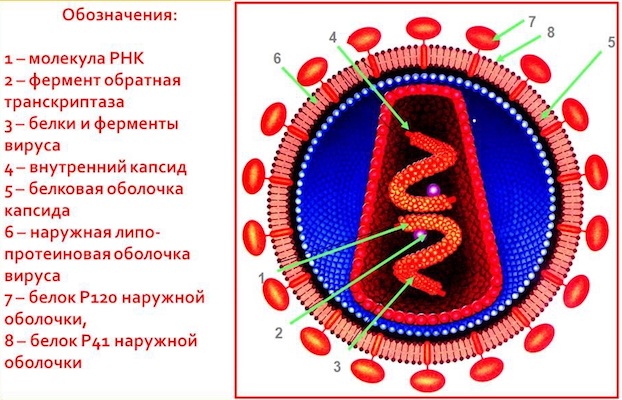
HIV - the human immunodeficiency virus first showed its terrible grimace in the early 80s of the last century. Then no one knew what it was, and the virus itself did not even have a name. Further research has shown that HIV is a retrovirus that infects the cells of the human immune system, one of the most important systems. The result of the work of the virus is the suppression of the immune defense and the development of AIDS, an acquired immune deficiency syndrome. In this state, the body remains defenseless, and any, even the easiest, infection (as well as cancer cells) can have a dramatic effect on it. In essence, HIV destroys our defenses and enemies in the face of infections quietly seize the body.
HIV has a contact mechanism of transmission. Infection can occur through contact with blood, semen, breast milk, pre-seminal fluid, or vaginal secretions. In other words, unprotected sexual intercourse, infected medical instruments, even non-disinfected needles in tattoo parlors are a great way for the virus to spread. During the period of the emergence of HIV, when panic among the population was spreading faster than reliable information about what HIV is and how it spreads, it was believed that you could get infected with a simple handshake. This is a myth, because the virus does not spread through a simple touch with an infected person. However, such a variant of infection is also possible, but only in the case of open wounds in the hands of an infected and possible victim of infection. I’m not even talking about the fact that some considered mosquitoes to be carriers of HIV (the mosquito drinks the patient’s blood and, having bitten a healthy person, can infect it) is also a myth.
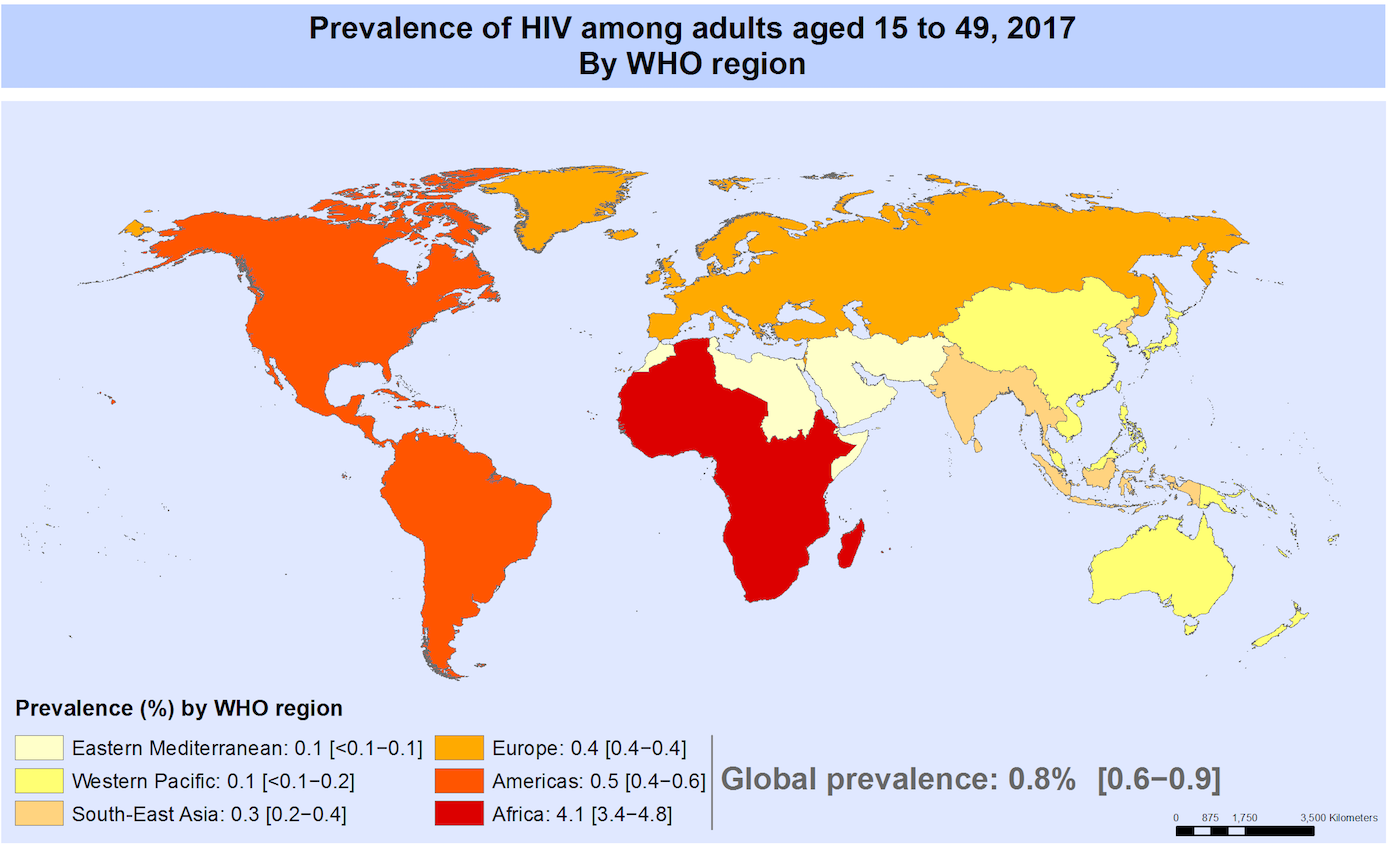
The prevalence of HIV in the world according to the World Health Organization (2017).
I will not describe in detail the virus and the consequences of its development in the body, because we are going to discuss not so much the virus itself, as a new method for its diagnosis. But it is worth noting that HIV is a patient virus that can mutate in the body of an infected over time, which makes it even more resistant to various methods of containment or treatment. This is another reason why it should be discovered as soon as possible. The more time the virus has, the stronger it is, and the weaker the infected person.
What does the device consist of?
Scientists involved in this study say that one of the most serious problems and obstacles in the early diagnosis of HIV, like other diseases in the world, is the lack of appropriate conditions: laboratories, personnel, medical facilities. That is why they decided to create a device that can accurately indicate whether there is a virus in the body or not. Blood sugar levels can be checked for a long time using portable compact devices (glucometers), that is, without the need to visit the laboratory and wait for test results for several days. The cost of such devices is quite low, which also accompanies their distribution.
The device with which we will be acquainted today can be briefly described as follows: a mobile analyzer for the molecular determination of HIV-1 based on looped isothermal amplification (LAMP) and nanomotors (CALM). And now in order.
Nanomotores
Nanomotors (also called micromotors) are microscopic molecular devices that can transform energy in motion. If they are placed in a certain chemical solution, they begin to move independently along a certain route, which can be used in diagnostics, and even in the power supply of nano-technological devices.

The formation scheme of micromotors for HIV tester.
Micromotors are polystyrene spheres coated with Pt (platinum) nanoparticles with a density of 1.04 g / cm. Further, Au (gold) nanoparticles were used to modify micromotors with DNA probes (in the diagram above, they are represented as red "tentacles").
TEM (transmission electron microscope) showed that the platinum and gold nanoparticles used in the coating of micromotors were spherical in shape, and their diameter was 57.721 ± 5.181 nm (Pt) and 3.43 ± 1.336 nm (Au).

Above are the TEM images, photo flasks with prepared nanoparticles and the results of optical spectroscopy.
It was necessary to check how efficiently a DNA probe of a fully formed micromotor can capture DNA molecules. An agarose electrophoresis * (C 12 H 18 O 9 ) gel was used for this.
Agarose * is a linear polysaccharide formed by a sequence of β-D-galactopyranose and 3,6-anhydride-α-L-galactopyranose residues combined by a 1 → 4 bond. It turns out from agar.

This technique allowed us to confirm that micromotors have DNA probes on their surface, since they were able to attach an artificial DNA molecule of about 180 bp (paired bases), which is an excellent result for such (artificial) sample (left image). The degree of capture efficiency was about 30% during the first tests, which is confirmed by fluorimetry (left image).

Here we see how micromotors move in solution with different concentrations of H 2 O 2 (0, 5, 10 and 15%).
It was also necessary to check the most important feature of micromotors - movement. For this, a solution with and without H 2 O 2 was used (comparison of the trajectories in image d below). When hydrogen peroxide was absent, micromotors vibrated due to Brownian motion. When H 2 O 2 was introduced into the solution, the speed of movement of micromotors increased by about 0.7 µm / s for each 1% hydrogen peroxide in solution.
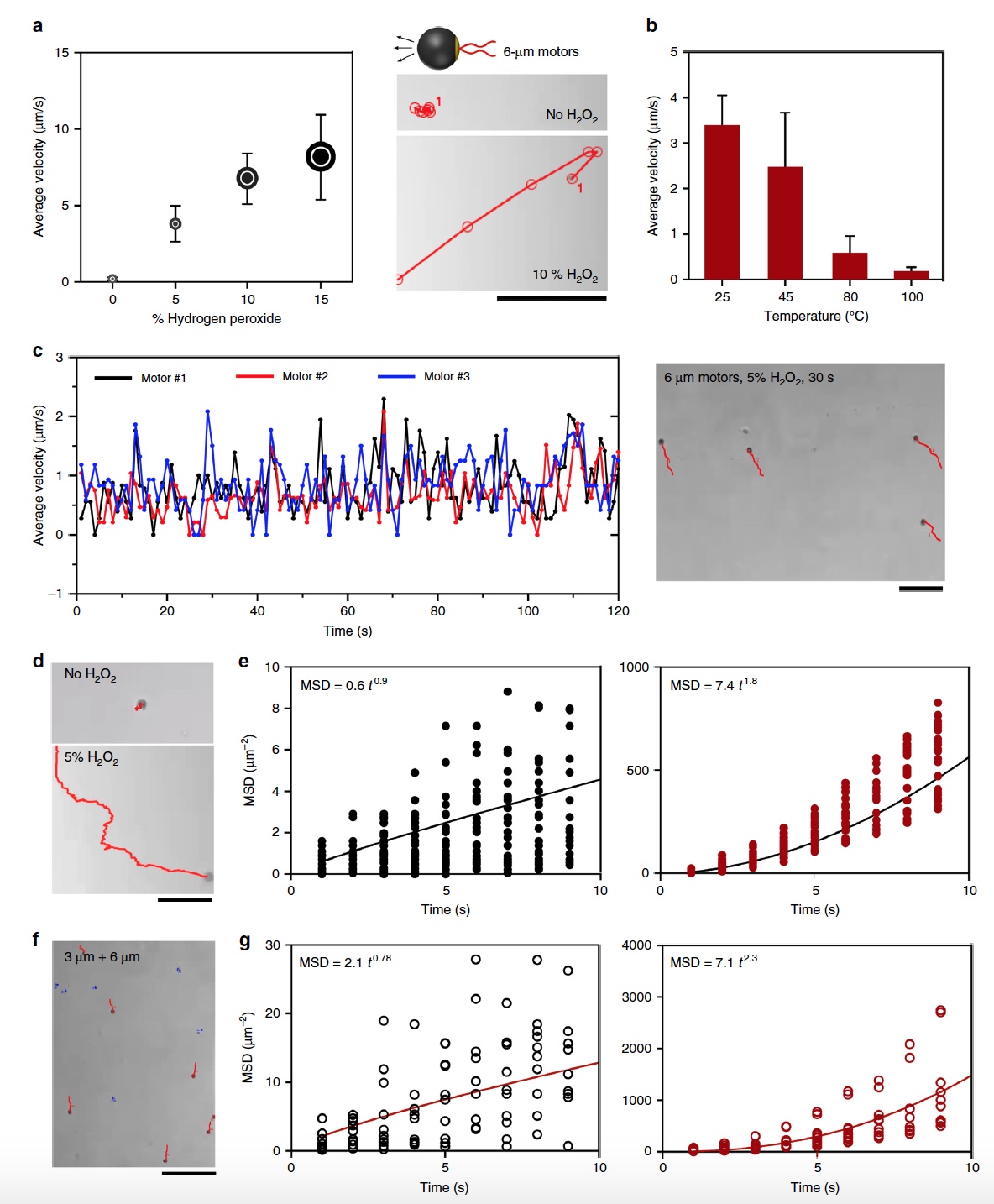
Measurement of the speed of movement of micromotors in the test solution.
The graph of a shows the dependence of the speed of movement of micromotors with a diameter of 6 μm and the concentration of H 2 O 2 in solution. Also (on the right) is a snapshot of the micromotor and the trajectory of its movement. Diagram b shows the degree of stability of micromotors at different temperatures in 5% hydrogen peroxide solution. Below (graph and snapshot), we see how the stability indicator changes over time (120 s), as well as the trajectory of movement already in a 15% solution. RMS offset over time is shown in graphs f : black dots - solution without H 2 O 2 , red - 5% H 2 O 2 .
Below, in the image f , we see that not only the state of the solution, where the micromotors are located, affects their behavior, but also the micromotors themselves, or rather their structure, also significantly change it. We see how micromotors with a diameter of 3 μm, without deposition from platinum and gold, move (blue lines) in comparison with high-grade tested micromotors with a diameter of 6 μm (red lines). To the right of the trajectory comparison, a comparison is given to the mean square displacement of micromotors (3 μm and 6 μm in diameter).
Mobile device
The Motorola XT1575 phone (Android OS) served to visualize and track micromotors (that is, to monitor how diagnostics are performed).
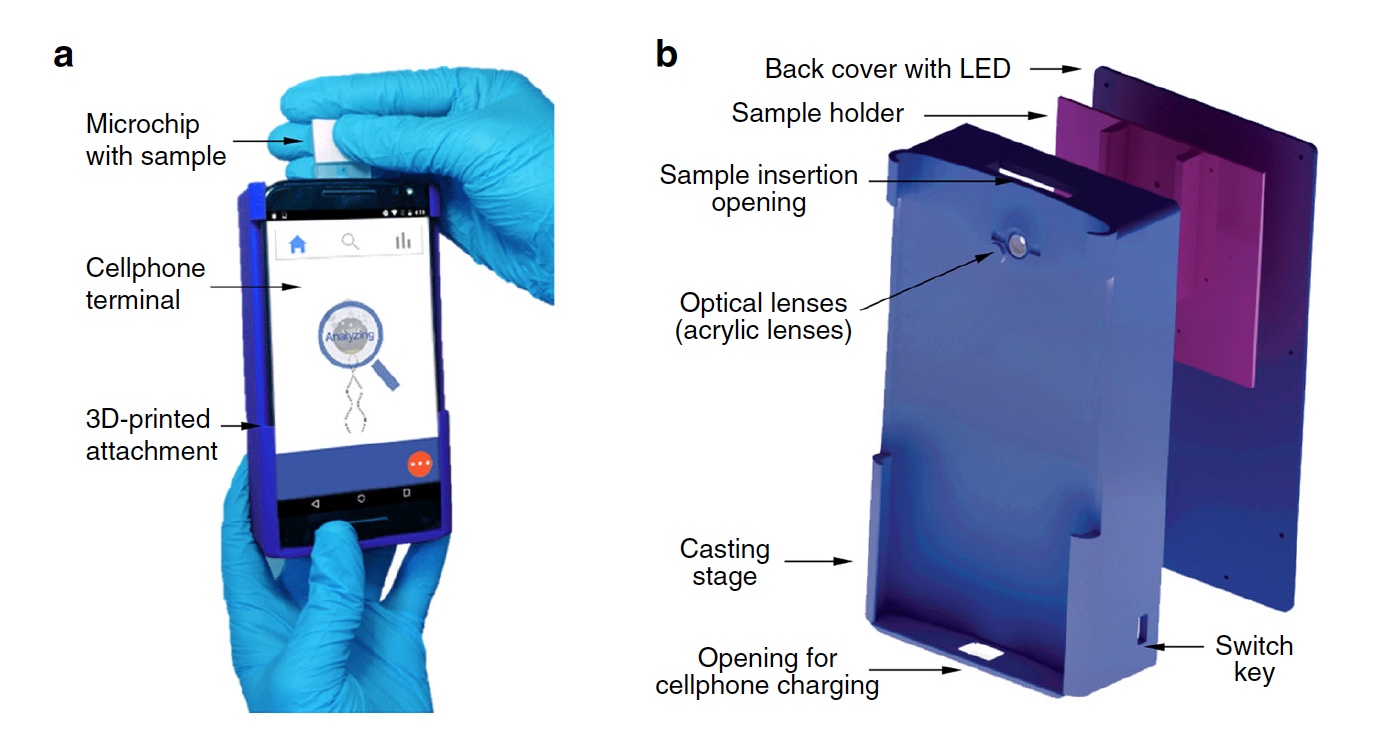
Appearance and details of the device.
An important component of the device is the chip needed to check the movement of micromotors. It was made of polymethyl methacrylate (from plexiglas). A glass base with a laser cut out “channel” with a width of 2 mm was attached to it using an 80 μm layer of glue.
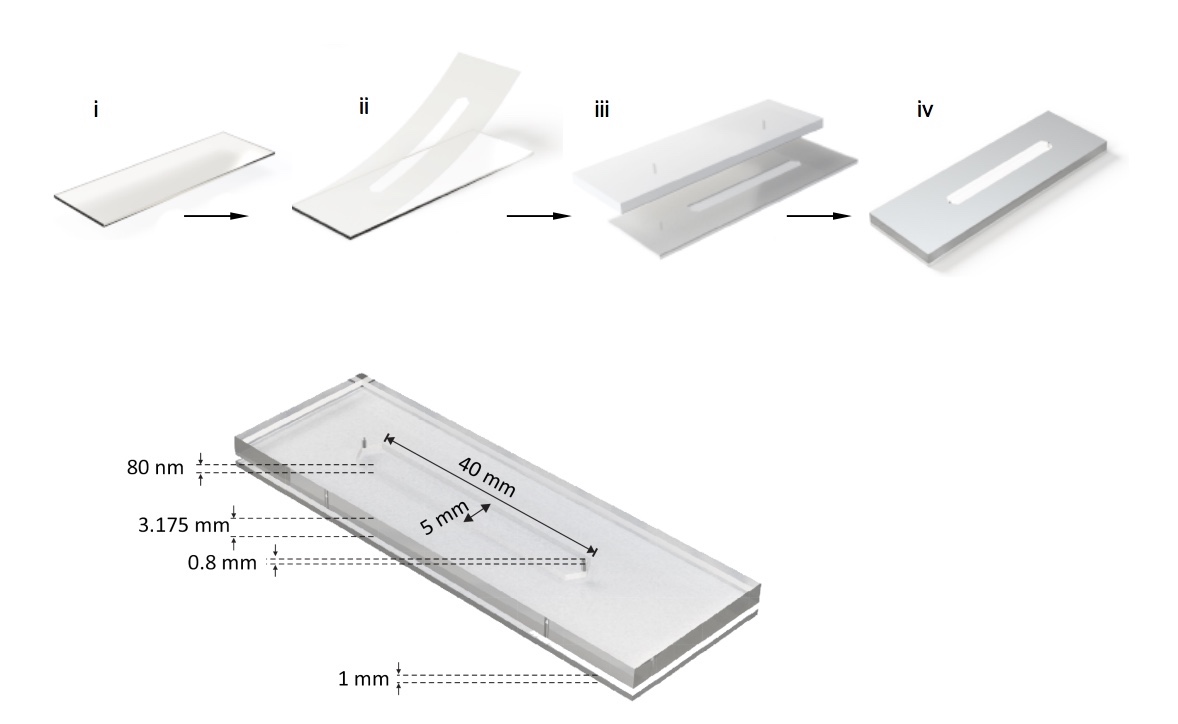
The appearance of the chip and its dimensions.
As can be seen from the pictures above, the chip is not the only part of the device. The blue removable case was made of inexpensive materials on a 3D printer. Inside this case there is a white LED, a 3.3 V battery, a switch and inexpensive optical lenses. Also in the case there is a sample holder that allows placing them between the lenses and the camera of the phone.
And now about the software component. The software was created in Android Studio using the OpenCV 3.1.0 libraries. The interface, according to scientists, has been made as clear and practical as possible for users.
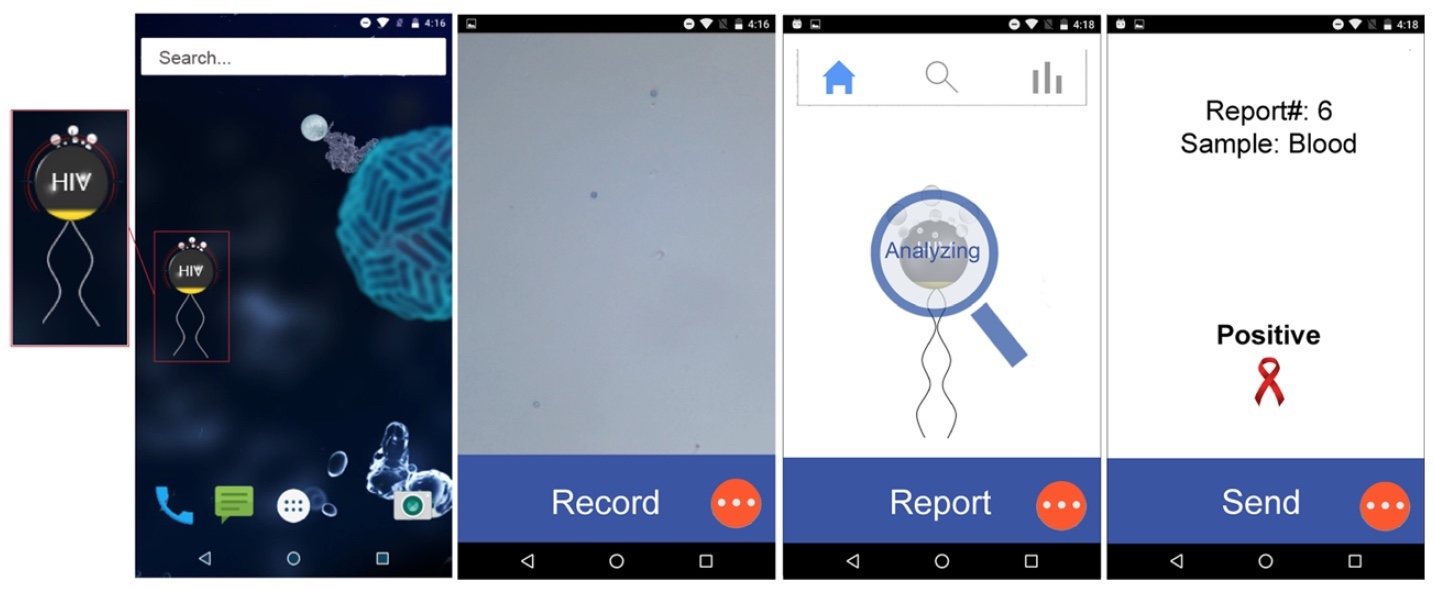
HIV tester interface.
When a sample is placed in the device, the program records video (30 fps, 320x240 pixels), on which the movement of the micromotors is visible, calculates their movement speed and gives the result of the analysis for 1 minute.
Loop Isothermal Amplification (LAMP)
How effective is the micromotor system capable of identifying HIV-1? The answer to this question lies in the LAMP reactions. For testing, several samples were prepared with different concentrations of HIV-1 RNA (ribonucleic acid). The amplification result was assessed by agarose gel electrophoresis.

LAMP testing.
The results of electrophoresis showed a stepwise formation of large DNA amplicon (DNA sequence, the result of amplification). The number of amplicons was found to be proportional to the concentration of HIV-1 RNA.
Micromotors were mixed with amplicons of HIV-1 RNA, making it possible to undergo the process of hybridization (at a temperature of 80 ° C). Next, the resulting "mixture" was tested in a 5% solution of H 2 O 2 . When HIV-1 RNA amplicons were present in the system, the speed of movement of micromotors decreased greatly, by about 95.26%. A decrease in the rate is observed even with an insignificant concentration of amplicons (about 3.394 ± 0.245 ng / μl).

Demonstration of micromotor movement in the absence of HIV-1 RNA.

Demonstration of micromotor movement in the presence of HIV-1 RNA.
Scientists also managed to restore micromotors and their speed. For this, the "infected" sample with micromotors and amplicons was incubated for 30 seconds at a temperature of 90 ° C. This allowed the amplicons to be freed from the micromotor DNA probes. This was followed by centrifugation at 6000 xg for 5 minutes. Checking the obtained sample in a 5% H 2 O 2 solution showed that the micromotor speed was restored to the level of 75.52% from the original, before testing with the participation of HIV-1 RNA amplicons.
The reaction of the system to other types of sexually transmitted viruses was also checked: hepatitis C and B, herpes, papillomavirus 16 (HPV-16). Due to the frequent cases of parallel infection of both HIV and some of the above viruses, this test was also of great importance. The result was satisfactory - DNA amplicons were formed only in the presence of HIV. That is, the presence of other viruses in the tested sample did not affect the process of testing it.
The conclusion is simple - the method is able to determine the presence of HIV. But now it is necessary to calibrate so that the system can distinguish the presence and absence of the virus in the sample, focusing on the standard value of 1000 particles / ml. If the concentration is below this index, the result is negative (there is no virus), if the concentration is higher, it is positive. For calibration it was necessary to determine what speed micromotors correspond to what concentration. For this purpose, PBS was used - sodium phosphate buffer (special solution for research) and plasma of patients with and without HIV.
Calibration was performed using PBS, in which the concentration level of synthetic stabilized HIV-1 RNA ranged from 0 to 107.
After calibration, it became clear that the average speed of micromotors at an HIV concentration of 1000 is 0.705 ± 0.082 µm / s.
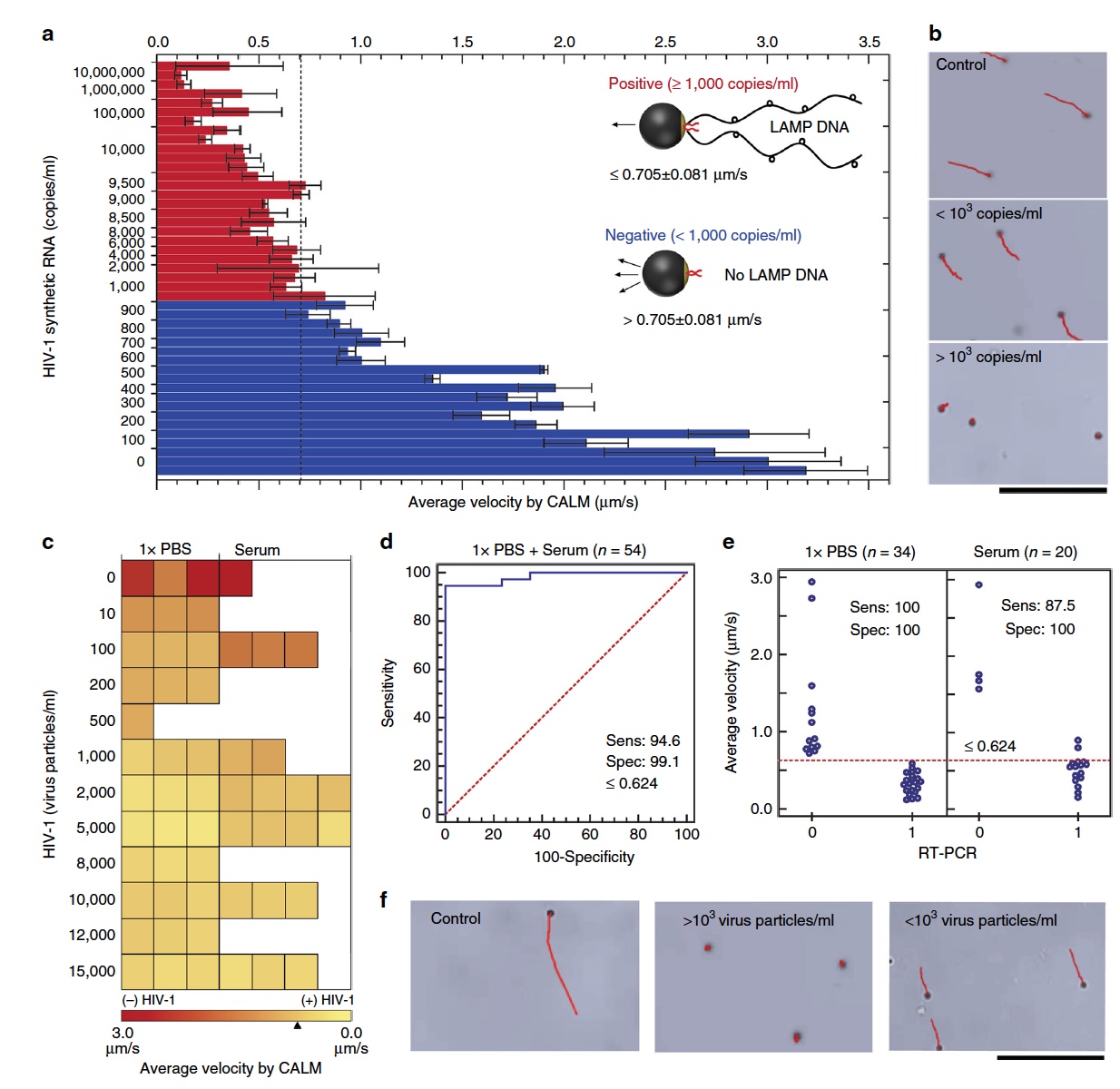
The results of determining the concentration of HIV-1 RNA.
Also, scientists conducted an analysis of the system using the ROC-curve, which showed very encouraging results. The sensitivity * of the test system was about 94.6% with a CI * value of 81.8–99.3%, and the specificity * was 99.1% with a CI of 80.5–100%.
Sensitivity * is an indicator reflecting the proportion of positive results (in this case it is the probability that the concentration of HIV in the sample is above 1000).The scatter diagram of the results of the system also showed incredible results. Thus, the accuracy of determining a sample with a high concentration of HIV as positive is 100%, and the accuracy of determining negative samples is 90%.
Specificity * is an indicator reflecting the proportion of negative results (in this case it is the probability that the concentration of HIV in the sample is below 1000).
CI * is the confidence interval, that is, the interval covering an unknown parameter with a given reliability.
Video materials:
Video showing how micromotors move when the HIV-1 RNA concentration is above the threshold value (the sample is positive).
Video showing how micromotors move when the HIV-1 RNA concentration is below the threshold value (a sample of the negatives).
Video showing how micromotors move when the HIV-1 RNA concentration is above the threshold value (the sample is positive).
Video showing how micromotors move when the HIV-1 RNA concentration is below the threshold value (a sample of the negatives).
Those interested in more detailed study of the study can look into the report of scientists and additional materials to it.
Epilogue
Scientists who created this amazing device, do not deny that they have yet to spend a lot of tests, calibrations, improvements. But they are clearly on the right track. Such devices can significantly reduce the rate of spread of HIV, especially among the population in places where laboratories with staff and lots of medical equipment are simply not available.
Yes, the device still does not look very compact and the fact that it requires the use of a smartphone can push someone away. However, in the future, such technologies for early HIV diagnostics will continue to improve, not only in terms of efficiency and accuracy, but also convenience and affordability.
HIV is the plague of the 20th century, as I wrote at the very beginning of this story. But, unfortunately, this virus is not so far from the title of “the plague of the XXI century”. Nowadays, several diseases are already claiming such a loud title (for example, depression, diabetes, etc.). And each of these diseases requires tremendous attention. And while there is no magic pill that can cure any ailment, we can only improve the existing diagnostic methods, which give us extra time to search for a cure or containment of the disease. As they say - the earlier we know about the problem, the more chances we have to solve it.
Another important point is social activity, openness and discussion. The problem should be discussed, because even if it is scary to talk about it, how does society intend to deal with it?
In any case, I have it all. Take care of yourself and your loved ones.
Thank you for staying with us. Do you like our articles? Want to see more interesting materials? Support us by placing an order or recommending to friends, 30% discount for Habr users on a unique analogue of the entry-level servers that we invented for you: The whole truth about VPS (KVM) E5-2650 v4 (6 Cores) 10GB DDR4 240GB SSD 1Gbps from $ 20 or how to share the server? (Options are available with RAID1 and RAID10, up to 24 cores and up to 40GB DDR4).
VPS (KVM) E5-2650 v4 (6 Cores) 10GB DDR4 240GB SSD 1Gbps until December for free if you pay for a period of six months, you can order here .
Dell R730xd 2 times cheaper? Only we have 2 x Intel Dodeca-Core Xeon E5-2650v4 128GB DDR4 6x480GB SSD 1Gbps 100 TV from $ 249 in the Netherlands and the USA! Read about How to build an infrastructure building. class c using servers Dell R730xd E5-2650 v4 worth 9000 euros for a penny?
Source: https://habr.com/ru/post/429594/
All Articles